- Port Overview
- Port Picture
- Description and Contacts of Key Companies
- Port Performance
- Discharge Rates and Terminal Handling Charges
- Berthing Specifications
- General Cargo Handling Berths
- Port Handling Equipment
- Container Facilities
- Customs Guidance
- Terminal Information
- Stevedoring
- Hinterland Information
- Port Security
Port Overview
The port of Durban is the main container port on the South African coastline. While handling approximately 60% of South Africa’s container traffic, the port serves KwaZulu-Natal, the Gauteng region and a large portion of the Southern African hinterland. Together with containers the port also accommodates dry bulk, liquid bulk, automotive and break bulk. Other present port activities, include facilities for local fishing industry, ship repair industries, visiting cruise liner vessels and recreational boating. The Port of Durban is bounded by the city of centre to the north, residential areas to the west and east, and industrial land to the south.
The port, like all others in South Africa, is operated on a common-user basis and is managed by Transnet National Ports Authority (TNPA) – through it’s terminal operators organ Transnet Port Terminal (TPT), which provides and maintains the infrastructure as well as the superstructure of the port. TNPA provides cargo handling (except stevedoring aboard vessels which is undertaken by private enterprise) and marine services including tugs and pilotage. Cargo handling facilities are provided on a non-discriminatory basis, whilst vessels are served on a first planned-first served basis. Where necessary, special purpose quays may be provided on a common-user basis for the handling of specific commodities or types of cargo such as ore, grain, bulk cargoes, unitised cargo and containers.
Port website: http://www.transnetnationalportsauthority.net/OurPorts/Durban/Pages/Port-Directory.aspx
Key port information may also be found at: http://www.maritime-database.com
|
Port Location and Contact |
|
|---|---|
|
Country |
Republic of South Africa |
|
Province or District |
KwaZulu Natal |
|
Nearest Town or City with Distance from Port |
Durban (0 km) |
|
Port's Complete Name |
Port of Durban |
|
Latitude |
-29.881 |
|
Longitude |
31.0265 |
|
Managing Company or Port Authority |
Transnet National Ports Authority |
|
Management Contact Person |
Moshe Motlohi, Port Manager Tel (27) 031 361 8821 Email: moshe.motlohi@transnet.net |
|
Nearest Airport and Airlines with Frequent International Arrivals/Departures |
AIRPORT NAME : Durban International Airport (King Shaka Airport) (DUR / FALE) 17.1 km from port LIST OF INTERNATIONAL CARRIERS : Mango Airline (JE), Comair (MN), South African Airways (SAA), Emirates (EK), British Airways (BA), Air Mauritius Airways (MK) |
Port Picture
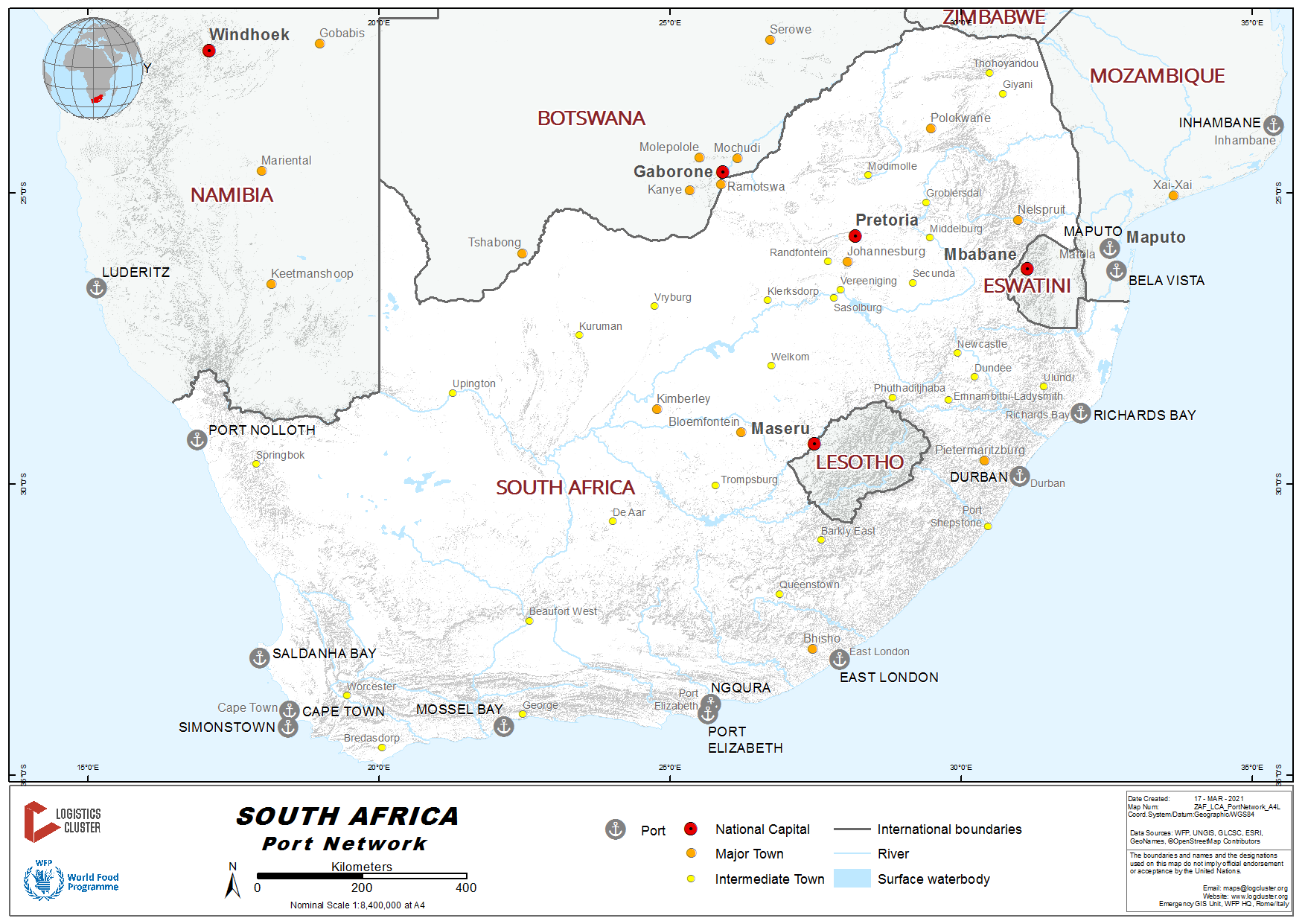
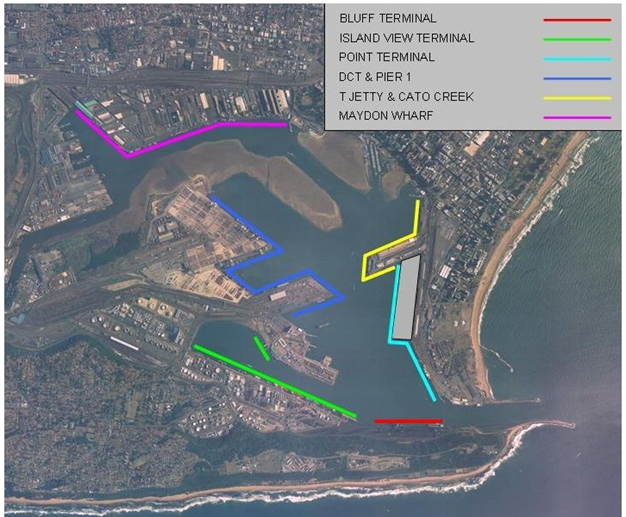
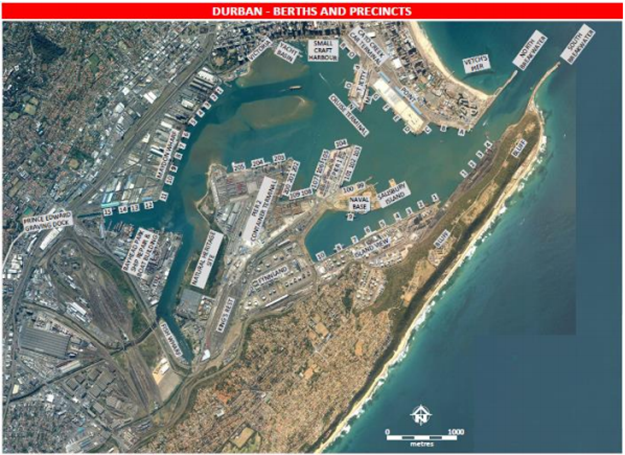
Description and Contacts of Key Companies
A number of companies operate within the port precinct and offer diverse or specialised services. Within the port certain berths / terminals have been concessioned to private operators some of these are Maydon Wharf – operated by the Grindrod Group offering container and breakbulk facilities, as well as port of call for a regional feeder Ocean Africa Container Lines (OACL), Bluff terminal – providing mineral handling facilities and Island View – offering hydrocarbons handling facilities.
For more information on port contacts, please see the following link: 4.4 Port and Waterways Companies Contact List.
Port Performance
The Port of Durban offers extensive safe anchorage outside the port. The Port of Durban has 59 berths (not counting fishing and ship repair) and an inner anchorage in the bay. Operating 24 hours a day, the entrance channel is 19 meters (62.3 feet) deep and 222 meters (728.3 feet) wide. Vessels up to 300 meters (984.2 feet) long and 37 meters (121.4 feet) wide can easily enter the port. The port operates a fleet of tugs owned and operated by the National Ports Authority (NPA), and the NPA conducts dredging on an ongoing basis. The two main commercial container terminals in Durban harbour (Pier 1 and Pier 2) operates a fixed berthing window strategy or a CTOC (CTOC – determination and coordination of container terminal operations contract berthing windows, which guarantee a departure time on condition that a vessel arrives on schedule and doesn’t exceed the number of contracted moves), negotiated on an annual basis with major shipping lines. Outside of this agreement berth availability is limited, unscheduled vessel calls may subject to waiting between 3 – 7 days. In relation to prioritising of humanitarian cargo, no standing agreement exist, however arrangement may be made (on a vessel by vessel basis).
|
Seasonal Constraints |
||
|---|---|---|
|
Occurs |
Time Frame |
|
|
Rainy Season |
Yes |
From October to April |
|
Major Import Campaigns |
Yes |
From November to February |
|
Other Comments |
South African citrus fruit exports during the months of April to November places significant pressure on the port (terminal congestion) and logistics infrastructure (traffic and transport resource availability) |
|
Discharge Rates and Terminal Handling Charges
For information on port rates and charges, please see the following link: https://www.transnetportterminals.net/Customer/Tariffs/Forms/AllItems.aspx
Berthing Specifications
|
Type of Berth |
Quantity |
Length (m) |
Maximum Draft (m) |
|
Conventional Berth |
31 |
228 |
9.6 |
|---|---|---|---|
|
Container Berth |
10 |
295 |
11.9 |
|
Silo Berth |
N/A |
N/A |
N/A |
|
Bulk Liquid |
9 |
288 |
12.8 |
|
Berthing Tugs |
N/A |
|
|
|
Water Barges |
N/A |
|
|

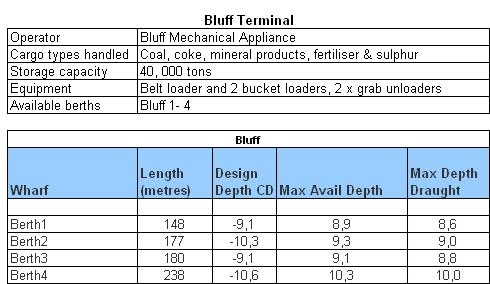

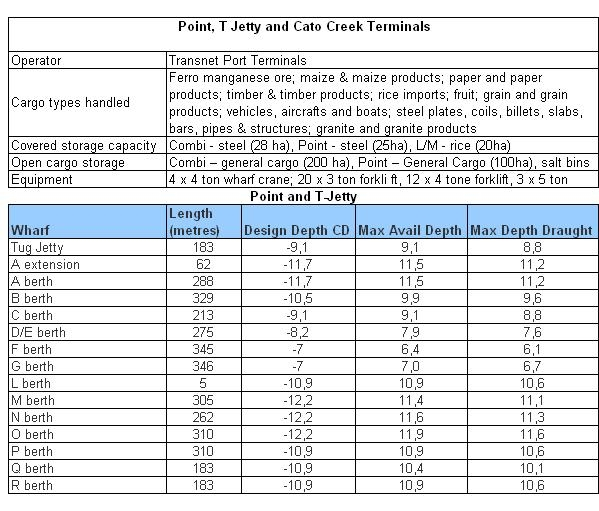
General Cargo Handling Berths
|
Cargo Type |
Berth Identification |
|---|---|
|
Imports - Bagged Cargo |
TBA |
|
Exports - Bagged Cargo |
TBA |
|
Imports and Exports - RoRo |
TBA |
|
Other Imports |
TBA |
Port Handling Equipment
Terminal assets within the two main container terminals (Pier 1 & Pier 2) are owned by the Transnet Port Terminals (TPT), a state owned company (SOC). Other leased terminals own handling equipment privately.
|
Equipment |
Available |
Total Quantity and Capacity Available |
Comments on Current Condition and Actual Usage |
|
Dockside Crane |
Yes |
2 x 50 MT 2 x 10 MT |
|
|---|---|---|---|
|
Floating Cranes |
Yes |
1 x 235 t at 10 m 1 x 125 t at 24 m 1 x 60 T at 6.1 m / 40.6 MT at 16.2 m |
|
|
Harbour Boat |
Yes |
1 |
100 passengers |
|
Floating Dock |
Yes |
2 4,500 MT 2 x 5 MT (electric) |
|
Container Facilities
The South African Government has embarked on a significant infrastructure drive to boost the economy and to alleviate poverty. As part of the MDS, Port Terminals will invest R37.2 billion over the next seven years to maintain and create new terminal capacity, ensuring that its terminals can facilitate projected demand. The container sector will see the largest expansion, with capacity increasing by 41% from 5,6 million twenty-foot equivalent units (TEUs) in 2014 to 7.9 million TEUs per year in 2021. The bulk sector will increase its capacity from 93 million tons per year in 2014 to 99 million tons in 2021, while break-bulk capacity will increase from 15.6 million tons per year in 2014 to 16.6 million tons in 2021. Automotive capacity will increase by 25% from 787,000 fully built units (FBUs) in 2014 to 987,000 FBUs in 2021. The fleet of ship-to-shore (STS) cranes in the container sector is planned to increase from 43 cranes in 2014 to 64 cranes in 2021. The number of straddle carriers will increase from 159 to 202; and there will be an increase in the number of Rubber Tyred Gantries (RTGs), from 72 to 140. In the bulk sector, the number of tipplers will increase from six to nine and the number of ship loaders/unloaders will increase from 19 to 21.
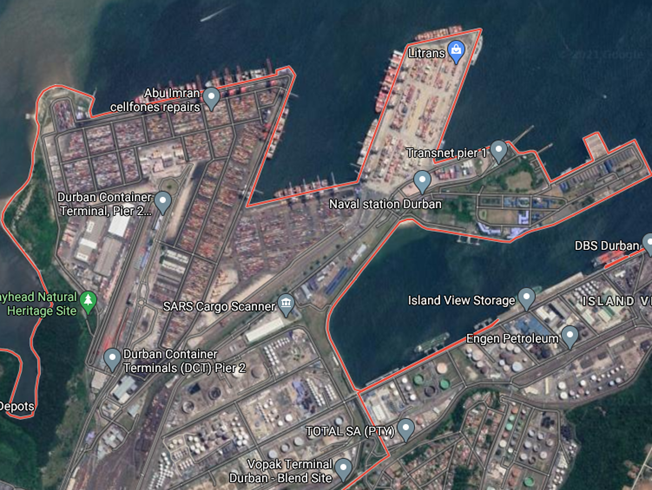
|
Facilities |
20 ft |
|---|---|
|
Container Facilities Available |
Yes |
|
Container Freight Station (CFS) |
Yes |
|
Refrigerated Container Stations |
Yes, pre-cooling facilities at berths O and P |
|
Other Capacity Details |
|
|
Daily Take Off Capacity |
N/A |
|
Number of Reefer Stations |
11 cooling chambers 27,000 m³ 69 pre-cooling funnels 9,500 m³ Open storage 4,000 m³ |
Customs Guidance
Customs and Excise office is located with the port precinct, customs also hold a 24/7 presence within the terminals for ongoing operations. Turnaround times are generally between 3 – 5 days from submission of clearance documents (without any queries). A container X-ray scanner is also located within the port precinct for any container deferred for further assessment, operating from 08:00 to 17:00. Various customs licensed depot are available in close proximity to the port for any such container deemed by customs to be opened for physical examinations. For vessels call the port customs & immigration will advise the Master of the local restrictions on berthing. Penalties are imposed for noncompliance with prescribed regulations.
For more information on customs in South Africa, please see the following link: 1.3 Customs Information.
Terminal Information
Multipurpose Terminal
The new MPT facilities at the Point incorporates a modern intermodal cargo exchange terminal, a bonded storage facility, and expanded cargo and container stacking areas covering about 20 hectares. The multi-purpose terminal, which handles break-bulk, bulk and containerised cargoes, has become this port's largest general cargo-handling facility. It operates across 14 berths at Pier 1, the Point and on the T-Jetty, and handles both import and export breakbulk cargo. Products handled at Durban MPT include steel, ferro-alloys, granite, rice, fruit and containers. A Ro-Ro terminal, mainly serving the coastal trade, is attached to the main container complex. A shed is available with an undercover storage area of 8 380 square metres. Total area (including Container Depot) 102.00 ha Actual container/Ro-Ro stacking area 26.33 ha. The Maydon Wharf MPT terminal operates across a number of berths at Maydon Wharf, principally between berths 8 to 13, and handles a variety of commodities, focusing on niche cargo including neo-bulks (salt, fertilisers and other mineral products, steel, scrap metal and forest products). The port has a well-equipped passenger terminal at N- berth on the T-Jetty for the convenience of cruise ships, which operate mostly between November and May.
Grain and Bulk Handling
There are 13 dry bulk berths at the Port of Durban with a current theoretical and installed capacity of 16 million tons per annum (MTPA). These berths include three berths at the Bluff, one berth at Island View
(IV3) and nine berths at Maydon Wharf. Rennies Bulk Terminals operates multi-product bulk handling facilities at Berth 5 at the Maydon Wharf in the Port of Durban. Products include wheat, rice, maize (corn), soda ash, fluorspar, soya meal, and palletized protein feeds. The terminal can store 100 thousand tons of agricultural products and 40 thousand tons of mineral products. This Port of Durban facility can bag 750 tons per day. Greystones Enterprises operates a Container Freight Station in the Port of Durban that is served by rail siding and roads. The facility offers the full range of services that include container stuffing and de-stuffing and cargo unitizing, including palletizing and bagging.
Main Storage Terminal
There are several privately-owned bulk storage and handling facilities in the Port of Durban. Outspan International operates a citrus terminal at the Port of Durban's Point with storage capacity of 176.2 thousand cubic meters for over 17.5 thousand pallets in 13 holding chambers. The Port of Durban's Citrus Terminal also has 72 rapid-cooling tunnels with capacity of 7.8 thousand cubic meters for 3456 pallets. The container area has capacity for 2356 cubic meters for 1040 pallets. The Citrus Terminal in the Port of Durban can handle 2000 pallets per day. SA Terminals operates a Bulk-Sugar Terminal at Berth 2 at the Maydon Wharf. It has capacity for 520 thousand tons in silos and for 57 thousand tons at the bagged sugar warehouse. The Bulk-Sugar Terminal in the Port of Durban can handle as much as 1000 tons per hour. Durban Bulk Shipping operates a multi-product bulk shipping terminal at Berth 3 at the Port of Durban's Island View facilities. Products include wheat, maize and maize products, vegetable oils, ores, and minerals. The Durban Bulk Shipping multi-purpose facility has capacity to store 68 thousand tons of bulk maize products, eight thousand tons of both andalucite and mono-calcium phosphates, 33.5 thousand tons of coal, 24 thousand tons of chrome ore, and 4956 cubic meters of vegetable oils.
|
Storage Facility – Contact |
|
|
Company |
Manica Africa |
|---|---|
|
Contact |
Dean Harris/Royston Denysschen |
|
Telephone |
+27(031)3280284 |
Stevedoring
Stevedoring in the terminal is offering by the terminal, however stevedoring companies may be contracted to the terminal or contracted freely on a vessel by vessel basis to vessels and their port agents
For contact information for stevedoring companies operating at the Port of Durban, please see the following: 4.4 South Africa Port and Waterway Companies Contact List.
Sturrock Grindrod - stevedoring operations are in Durban, Richards Bay, Maputo and Walvis Bay. Stevedoring services include the handling of bulk commodities, break bulk commodities, containers and vehicles.
P & O Ports Nationwide Cargo Terminals Sa (PTY) Ltd - Address: Bon1, Duncan Dock Rd, Table Bay Harbour, Western Cape, 8001, South Africa, Cape Town.
Bidfreight Port Operations - Address: Coode Cres, Table Bay Harbour, Western Cape, 8001, South Africa, Cape Town.
P S Port Stevedoring - Address: 35 Grunter Gully, Bayhead, Kwazulu Natal, 4026, South Africa, Durban.
Good Hope Stevedoring (PTY) Ltd - Address: Unit9 Auckland Pk, Auckland St, Paarden Eiland, Western Cape, 7405, South Africa, Cape Town.
Port Stevedoring - Address: Ste300 3 Mansion Hse, 12 Joe Slovo St, Central, Kwazulu Natal, 4001, South Africa, Durban.
Bay Stevedores - Address: Newark Rd, Richards Bay, 3900, SouthAfrica, Kwazulu Natal.
Bid Freight Port Operations - Address: 27 Church St, Central, East London, 5201, South Africa, Eastern Cape.
P & O Ports Nationwide Cargo Terminals SA (PTY) Ltd - Address: Eastern Cape, 6001, South Africa, Port Elizabeth.
Hinterland Information
The Port of Terminal is the main gateway seaport (by volume) to sub-Saharan Africa. From the port strategic channels are provided to facilitate the smooth flow of cargo from the port terminals and vice versa, these include a roadway systems that interlinks with the rest of the country and with neighbouring countries, rail services are also available from the port connecting the major commercial centres in a hub and spoke layout – also able to connect to some neighbouring countries, it further also like road transport links to multimodal transit hubs for further connectivity.
Port Security
There are police, ambulances and fire-fighting services available. Private security companies are available for 24 hour on-board service. Stowaways have become a problem in Durban and Masters are advised to take the necessary precautions and do stowaway searches before the vessel sails. Firemen are on duty at all tanker and bunker berths whilst vessels are working cargoes/bunkering. Transnet National Port Authority has installed advanced security features such as closed-circuit television for some of its terminals and Automatic Identification Systems (AIS) that allow for remote ship identification by port control. The most obvious aspect of this compliance is that it impact access to ports by non-port related users. Many areas previously accessible by the general public such as cargo working terminals and ship repair lay-up quays are now only accessible by authorized personnel. The new Security regulations required the appointment of a Port Security Officer for each port and a Port Facility Security Officer for each terminal. These persons will coordinate security planning, implementation and maintenance between the port authority and port facility operators.
The wide-area surveillance and perimeter protection solution at Durban Port is comprised of an 'intelligent' command and control system that transforms a network of cameras into intelligent object detection, tracking and recording sensors. At Durban's Port over 120 cameras were placed on the perimeter with the addition of 13 PTZ cameras. Any breach in the perimeter or suspicious behaviour detected by the cameras sets off an alarm in the control centre via the command centre software, enabling the security personnel can react accordingly.
|
Security |
|
|---|---|
|
ISPS Compliant |
Yes |
|
Current ISPS Level |
Level 1 = Normal |
|
Police Boats |
Yes |
|
Fire Engines |
Yes |


